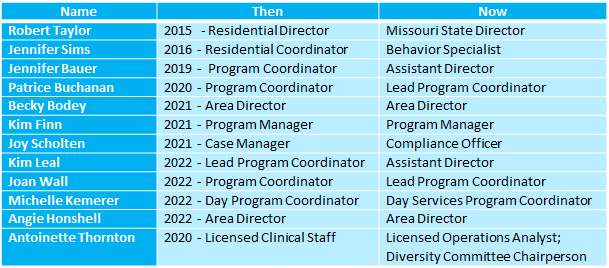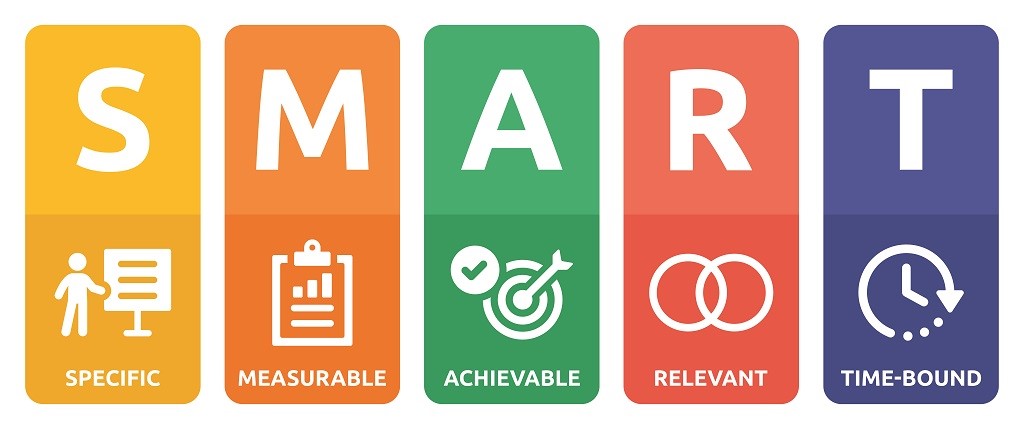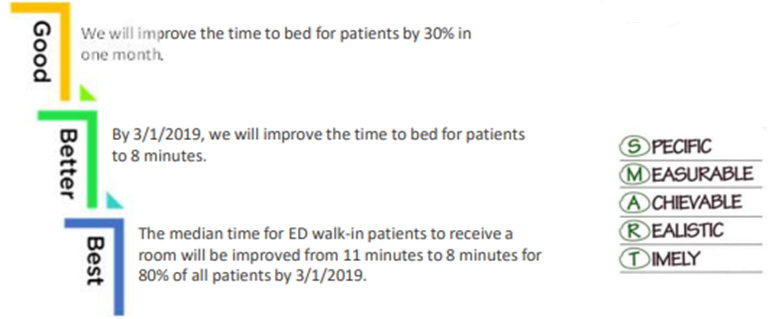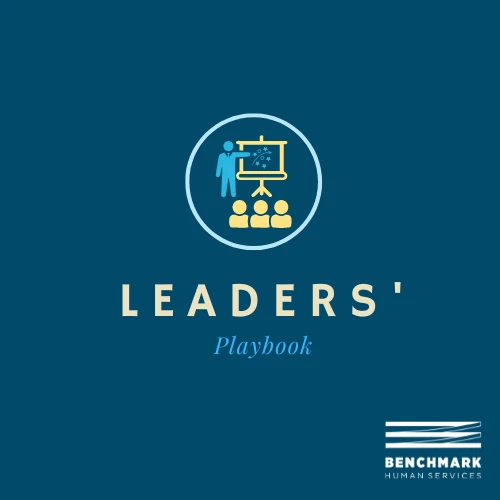Welcome to Leaders’ Playbook, the managers’ newsletter. We hope you find these materials informative, and please share any ideas you have for future issues with David Ross and Courtney Heiser!
Leadership and Values
By Doug Beebe, Chief Executive Officer
 If someone could only see my actions and not hear my words, what would
If someone could only see my actions and not hear my words, what would
they say are my priorities?
In many ways, this is the underlying premise of community-based care. Across all of our programs and states, we are often on our own and making decisions based on the values we share with Benchmark and the values that drove us into the human services field. All of us bring a different lens to our work, and through that wide variety of perspectives, we have been able to grow and see opportunities that many others have missed.
As leaders of dispersed and diverse work teams, the challenges can be immense. People look to all of us to see what Benchmark values. Are you a champion of the busy or the important? When you face tough decisions, do you put them off, or do you move forward and explain to those impacted why you made the decision you did? We all work with and lead teams that should be valued for their immense impact on the lives of those we serve, and those disruptive situations need to be resolved.
Many of us are not born with a natural response to make difficult situations easy. Instead, the response is a learned and practiced one. Delaying an investigation, not returning a tough e-mail, or ignoring a problem behavior never addresses the issue. Instead, resolving it quickly demonstrates how you value decisive leadership and the people involved. Our priorities should reflect the values we bring that brought us to this point in our careers.
Think about the leaders you have most enjoyed working with and for. Did they quote policies and rules or demonstrate a focus on quality and outcomes? I always valued the latter and have tried to incorporate what I could from them into my value set. As stated in our corporate principles: “Policies do not create quality, people do. If a corporation has the hearts and minds of its employees, then rules and policies are of little use.”
Building Provider Capacity
By Brian Gill, Vice President of Behavioral Health and Crisis Services

Benchmark strives to implement the concepts of diversity, equity, and inclusion throughout our work, including the development of new programs and services.
The Building Provider Capacity programs are no exception, reflecting the diverse populations we serve; equitable distribution of resources including specialized knowledge obtained through advanced education and experience; and an inclusive approach to all who require help.
The concept of the model is simple. Given our experience – and success – serving individuals with the most significant needs, often with reputations as “challenging to serve”, has taught us invaluable lessons that should be shared with other providers to successfully address the needs of individuals they support, not just those Benchmark serves directly. This commitment to meeting the needs of individuals by supporting providers benefits the service delivery network as we elevate the quality of services provided without displacing existing providers.
Listen as Arkansas State Director Charles Burd and Alabama State Director Melanie Bald share how Building Provider Capacity initiatives align with Benchmark’s values.
The ability to serve a diverse population – no matter what their needs are – allows the Building Provider Capacity model to be a highly adaptable service that easily augments existing Benchmark services as demonstrated through our conversations with State agencies and health plans interested in our outcomes.
Leveraging our team’s existing relationships in markets where we currently provide direct services has been a critical component in initiating conversations. For example, Chris Diehl has recently facilitated conversations with State officials from markets under his leadership to explore needs and potential partnerships.
As organizational leaders, we encourage you to think creatively about similar opportunities in your service lines and markets and to reach out to Sarah Chestnut for assistance with brainstorming and outreach.
DEI, Culture, and Connection
By Courtney Heiser, Chief Culture Officer
 Many of you participated in the Town Hall meetings with our DEI consulting firm, SimplyHR, to talk about the process of Benchmark’s DEI assessment and survey, as well as the next steps. By now, you should have all received your departmental scores from the survey. Participation was low in many markets, but results should still be considered as you think about the unique culture of your individual departments. One resounding theme in DEI work as it relates to workplace culture, is that employees crave connection – and that connection leads to longer retention and higher-quality output. In our world, that means better care for those we serve.
Many of you participated in the Town Hall meetings with our DEI consulting firm, SimplyHR, to talk about the process of Benchmark’s DEI assessment and survey, as well as the next steps. By now, you should have all received your departmental scores from the survey. Participation was low in many markets, but results should still be considered as you think about the unique culture of your individual departments. One resounding theme in DEI work as it relates to workplace culture, is that employees crave connection – and that connection leads to longer retention and higher-quality output. In our world, that means better care for those we serve.
After receiving their DEI scores, several departments are working on action plans to improve diversity, equity, and the sense of belonging within their departments. In Ohio, Ryan Knodel, director, and Chris Diehl, vice president, have developed a thorough plan which includes:
• Resuming DSP rallies
• Encouraging use of and connection through the Benchmark app
• Printing Thrive newsletter and getting it into homes
• More home visits from management
• Creating a “policy of the month” communication, etc.
Communications recently spent a day in Lima, Ohio with Ryan’s team. We had the opportunity to meet many front-line staff and even treat a group of DSPs to lunch. What we discovered through that conversation, is that those particular staff are hungry for connection. They want to meet and spend time with other DSPs in their markets. They need their managers to listen and understand. They want to be seen as fully human – not just a body to fill a shift.
Google “how to connect with employees” and you’ll find countless articles with tips on connection, many of which offer the same basic themes:
1. Give employees a voice and vote
2. Listen to feedback and take action
3. Empower employees to grow
4. Be authentic
5. Be present
6. Lead by example
7. Recognize and reward
If you’d like to brainstorm ways we can work together to help strengthen the sense of connection within your departments, please reach out to me. I would love to work with you and your managers to develop a plan to enhance Benchmark culture throughout your department and beyond. Additionally, you can find resources to help you connect in the “ROTC (Recruit Onboard Train Connect)” folder on the Shared Drive.
Management Development Program – Where We Are and Where We’re Going
By Eric Weeks, VP of Human Resources

In the March issue of Leaders’ Playbook I provided some history about Benchmark’s Management Development Program (MDP). The current program includes completing assigned projects and training in Human Resources, Payroll, Compliance, Communications, Legal, and IT. Participants also build connections with peers and senior leaders, tour facilities, book reviews, and lead training sessions, among other development opportunities.
Where Are They Now?
Since the program’s inception in 2014, approximately 18 managers and professional staff have participated in the MDP. Below are updates on many of those participants. “Then” represents the year they participated in the program and their position at that time. “Now” gives an update on their current role.

What’s Next?
The 2024 class will see more enhancements, including in-depth exposure to Lean Six Sigma, staff engagement, leading training sessions, and learning the elements of resilience coaching. Finally, the program will become known as Emerging Leader Development (ELD), focusing on training and educational opportunities designed to develop the hard and soft skills of those within the organization who are emerging as future leaders.
A call for 2024 nominations will be made in June 2023. In the meantime, vice presidents and directors who have questions may contact Eric Weeks.
Incorporating Lean Six Sigma into Every Day Work
By Ben Harrison, Communications Specialist
At Benchmark, we are striving to make processes more efficient by incorporating Lean Six Sigma practices into our work, adding value that ultimately benefits employees and individuals served. When starting a project, we want clear goals and expectations to accomplish the best result. One Lean Six Sigma tool with use is SMART goals.

A SMART goal includes details such as the timeline, location, and metrics to use to measure success. Here is an example of crafting a SMART goal:

With Performance Reviews coming soon, think of the best SMART goals you can set for the employees under your leadership. Having detailed goals will help employees know your expectations and achieve your desired results more easily.
Are you interested in more information about Lean Six Sigma? If you haven’t already, be sure to take the White Belt course on the HUB. Once completed, you may move on to Yellow Belt. Our next Yellow Belt virtual two-day training will be held on June 8 and 9 from 2:00-5:00 PM ET. Contact [email protected] if you are interested in participating.

